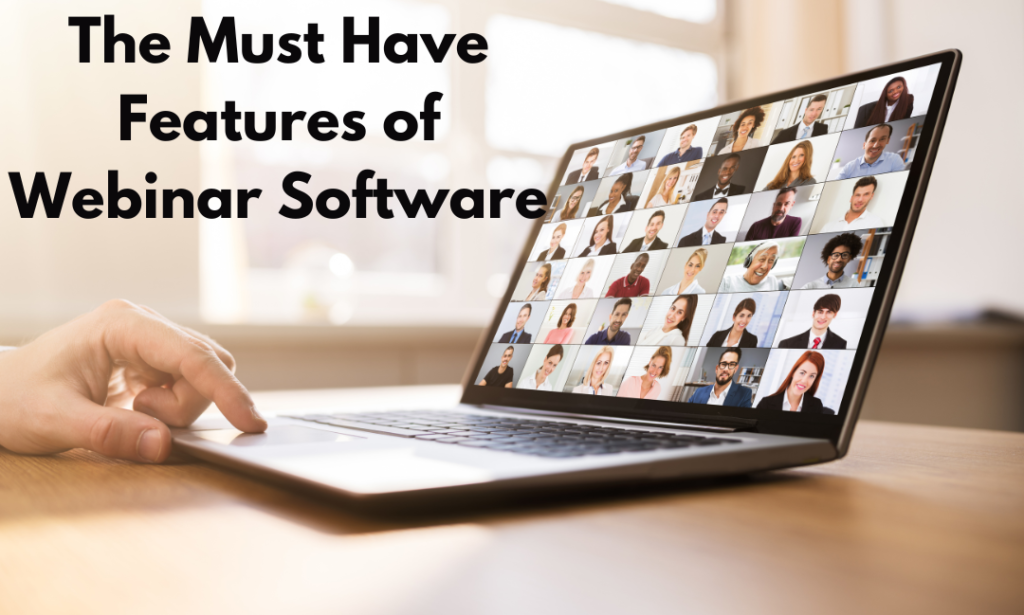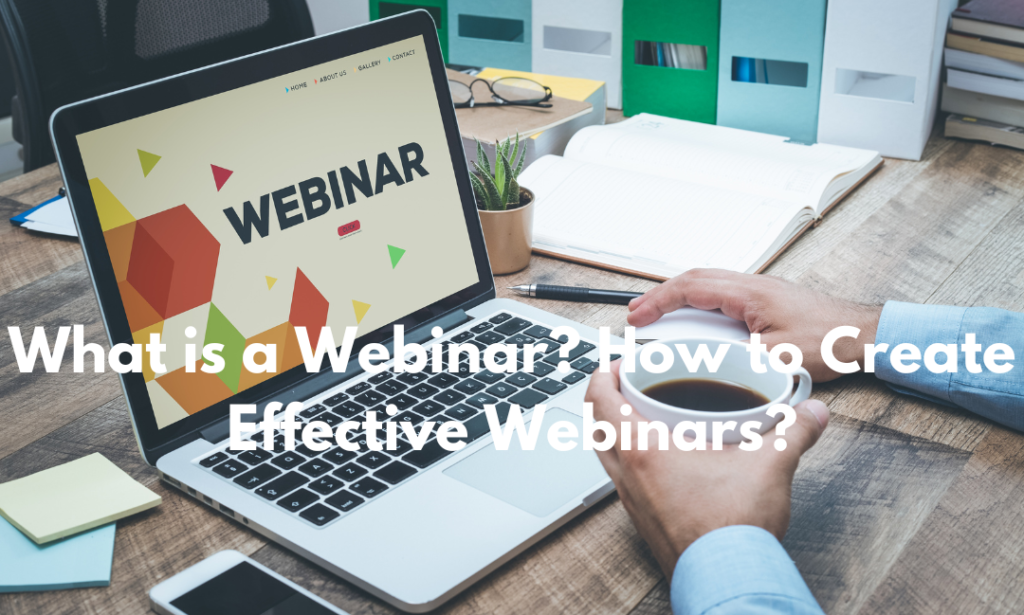And yet, somehow, this is the reality we live in today…
Where remote work is no longer stigmatized as being unproductive, and where we can connect with anyone, anytime, virtually, within seconds.
Especially with online events, where you can communicate your event’s message and purpose to a global audience, involving sponsors, partners, experts, speakers and everything else, the whole nine yards – All from the comfort of your home, with the click of a button, as long as you’re connected to the internet!
Among all the events that have shifted online today, webinars seem to take the cake when it comes to popularity! Webinars have transformed event marketing for almost every industry you can think of – from healthcare, to academia, to manufacturing, consulting, IT, retail, financial services and any other you can think of!
But are webinars really effective in real life?
Can you really create an impact on a virtual platform compared to in-person events?
To answer these and any other reservations you may have about webinars, we’ve put together this end-to-end guide where we’ll walk you through what a webinar actually is, its importance, and a step-by-step guide on how to create an effective webinar.
Let’s dive in!
What is a webinar, really?
For the uninitiated, the word ‘webinar’ is actually a portmanteau! It is a word that came about by blending two separate words – web and seminar.
So, in essence, webinar is, quite simply, a seminar conducted via the web.
Any type of online gathering that involves a speaker or an expert acting as the presenter of the content, and a virtual audience that is there to learn or benefit from the content can be considered a webinar. Today, webinars have become a key weapon in every marketer’s arsenal.
These online events can last anywhere between 20 minutes to an hour or more. Most successful webinars are shorter, lasting around 40-45 minutes with a brief Q&A session to make sure everybody attending the session gets the chance to clear their doubts in real-time.
Webinars allow a significant number of participants to gather together and engage in online discussions.
With the advent of webinar platforms though, there has been a whole new era in the events landscape as the entire experience is elevated to a level of absolute professionalism and end-to-end value for all parties involved.
We’ll explore in detail all the features that a good webinar platform must have in later sections of the blog. So, read on!
Advantages of Hosting a Webinar
There are several reasons for businesses to host webinars like growing revenue, promoting brand awareness, generating high-quality leads, training internal teams and so on.
Let us examine some of the benefits they provide in detail:
Generation of Leads
Lead generation is arguably the most important part of any organization’s growth strategy, and webinars ensure that this is done efficiently. Sure, businesses can generate leads from a number of sources or channels, but webinars provide high quality leads for a fraction of the cost that other marketing sources may consume.
Training and Educating
A significant benefit of webinars is that they can be very impactful in training and educating audiences. Whether they are internal employees whom you want to train on company policy or external customers whom you want to educate about your products, webinars always come up as a powerful tool to cater to your audience, effectively.
Cost Effectiveness
One of the biggest benefits of hosting a webinar is its cost effectiveness. An in-person event involves a ton of things to be taken care of, like travel expenses, catering, the venue and its rentals, etc. Webinars, on the other hand, are a budget friendly option, particularly for companies and individuals with a modest budget.
Wider Reach and Accessibility
Webinars allow access to thousands of prospects across the globe, irrespective of their geographical location, as all they need to access your virtual event is a stable internet connection and device to log in from. This helps you expand the reach of not only your target audience, but also your target geos.
Attendee Convenience
Webinars give participants the luxury of learning about valuable subjects and from experienced, expert speakers, without having to go through the hassle of traveling to any location, from the comfort of their own space and device!
This opens up the opportunity for a lot of people from around the world to take part in webinars, as the convenience it provides is unparalleled. It is a win-win for organizers and attendees, as it involves lesser investment from both parties in terms of time, effort or resources, compared to an in-person event.
Content Repurposing
Another significant benefit of hosting webinars is that the content can be used to further maximize their value. Repurposing webinar content and sharing it with relevant audiences in the form of a blog post, an infographic, videos, clips or social media or even for podcasts, helps you generate on-going value from a single event.
Provides Analytics and Insights
Most webinar platforms in the market provide webinar analytics and insights to measure the overall performance of the event, which includes engagement rates, attendance rates, drop offs, depth of engagement, etc. This data can be further used to improve your next webinar performance.
Fundamentals of hosting a webinar
Now we’ve gone through what webinars actually are, and examined some of the benefits they could provide you with, let us now look into the fundamentals of hosting the perfect webinar.
1. Set a clear goal
Executing tasks will be easier if you have already defined your specific goal or objective. The clearer the objective, the higher the chances of success.
2.Understanding your audience
Have a thorough understanding of your audience’s requirements, their pain points, their interests and preferences, and create a compelling webinar title accordingly.
3. Schedule your webinar at the right time
The right event hosted at the wrong time can do more harm than good – and will suffer from fewer registrations and attendance than it deserves! Identify the time slot that is most suited for your specific target audience and schedule the time, date of the webinar accordingly.
4. Market your webinar effectively
Promoting your webinar such that it reaches your audiences far and wide, is vital, as this will directly determine the registration and attendance rate. The better the marketing of your webinar, the higher the attendance rate on the day of the event.
5. Creating your presentation
Examine your webinar script and speaker preferences and choose the appropriate presentation format that best suits your webinar topic, audience and material, to deliver maximum value to your participants.
6. Host a rehearsal or two before the event
Make sure to conduct an end-to-end rehearsal of the entire webinar before the day of the event. Ensure the content flow and presentations are in place, test your technical setup and backups, including your laptop and internet connectivity, etc, familiarize the guest speakers on the webinar platform, etc. Address any issues you may have observed during the rehearsals, so that the main event carries on smoothly and efficiently.
How do you create an effective webinar?

Here are some tips to help you deliver an effective webinar that converts:
The Webinar Topic
Brainstorm webinar topic ideas by identifying how you can address your audience’s concerns with your product/ services , and then finalize on a topic that addresses their needs as well as your event’s goals.
Depending on the format or purpose, the webinar topic can also revolve around a new product launch, feature launch, product training for existing customers, etc. If the purpose is internal employee training, then of course, the topic will be decided based on the training module and requirements.
Different webinars follow different protocols, when it comes to selecting the topic and this depends on their purpose. Select your ideal webinar topic accordingly.
Select the Content Delivery Format
Select a particular webinar format to deliver the content efficiently. To make your webinar effective, leverage a unique format that not only complements the topic, but also facilitates engagement among the audience.
Some of the common webinar formats include:
- Single Speakers – Single Speaker webinars involve a single speaker who’s in charge of presenting the entire webinar – all the content, discussions around the topic, audience Q&A session, etc. These types of webinars are ideal when the speaker is an expert on the concerned topic and the webinar size is relatively small.
- Interview – The interview format generally involves a couple of speakers discussing the topic, where one generally poses a question and the other, being an expert on the topic, answers.
- Panel Discussion – Panel discussion is where there are multiple speakers present to discuss the webinar topic along with a moderator who directs the discussion.
- Q&A Sessions – The Q&A form is where the audience members replace the interviewer. Here, respondents are engaged in live webinar, posing questions in real time or having submitted some questions beforehand, which are eventually discussed during the webinar
Work on the Webinar Content
The most vital part of executing the webinar is delivering the content impactfully. What is also just as vital is figuring out, in advance, the type of content you want to deliver, its importance, and the aspects of the webinar content that your audience will be able to relate to. Make sure that the information you’re delivering to the webinar participants is accurate.
If you’re working with multiple speakers or presenters, discuss and divide the topics among them as to who will present which part of the content, based on their expertise. Outline the key points in a logical sequence so that both parties, including the presenter and the audience, can understand it with ease.
Now Assemble your Team
Assembling your team refers to putting together the set of people involved in planning, executing and hosting the webinar. This includes every single person of your team, starting from the organizer, moderator or interviewer, assistants, presenters, tech support staff, marketers, etc. Discuss their roles and responsibilities with them before the webinar, so that your event goes smoothly.
Select a Webinar Platform and Schedule the Event
In the long-term, this is the most important investment you will be making to empower your event marketing team. Make sure that you choose the software that accommodates all the features you’re looking for, and will help you simplify and streamline your efforts.
Look into the capabilities, customer testimonials, user reviews on software review sites, the scalability options, the budget and pricing tiers, the customer support assistance, and assess the tool properly before deciding on your webinar platform.
And once you’ve selected the platform, it’s time to schedule your event.
Promote your Webinar
As mentioned earlier, promoting your webinar should be extremely effective to drive maximum registrations for your event. Make sure people receive a consistent message about the webinar across all promotional touchpoints.
Your landing page is the heart of your promotion campaign, from where all registrations happen – so ensure that it is impactful and inclusive of all relevant information. Talk about the content of your webinar, the speakers, and when it is scheduled.
Make your promotional campaign diverse and inclusive with email marketing, social media marketing, targeted ads, pop ups on the website, influencer marketing, etc.
The Must-Have Features of Webinar Software

As mentioned above, investing in the right webinar platform can be a game-changer for businesses.
Here are some of the key features that you should look for while choosing a webinar software.
Video Conferencing
Video conferencing is a primary feature in any webinar software, but make sure you choose one with best-in-class audio-visual capabilities. Your participants should clearly see and hear you, for you to be able to get your message across clearly.
Session Recording
Session recording is a great feature for you to look for in your webinar platform as it empowers you to extend the lifespan of your event. Whether you send across the webinar recording to the registrants who couldn’t make it to the webinar, or leverage the recording to repurpose it into different content formats for marketing purposes – this feature is a must.
Screen Sharing
Screen sharing also comes among those features which come with almost every webinar software but again, make sure that it doesn’t have any drawbacks and is compatible across devices. It helps you to present your data and ideas more efficiently, and you can conduct demonstrations with relative ease.
Engagement Capabilities
Audience engagement is another must-have feature you need to look for in a webinar software. All the efforts that go into hosting a webinar go in vain, if your audience doesn’t engage with your content in a meaningful way. And your webinar software plays a critical role in supplementing your efforts to build engagement.
Ensure that the software has features like –
- Live Polls and Quizz
- Chat & Comments
- Emoji Reactions
- Breakout Rooms
- Gamification
- Chat Feature
You can employ several methods like Q&A sessions, interactive quiz games, etc, using the engagement features that your software has.
Airmeet, a webinar platform, comprises all these unique features and can help you deliver a breathtaking experience to the webinar participants. Starting from breakout rooms, live polls and post webinar surveys, it has everything to offer to make a webinar an effective one.
More on how Airmeet can help you deliver the best webinar experience below. Read on.
Analytics & Reporting
Choose a webinar software which helps you track down the insights to deliver better event experiences in the future. Your webinar software should be able to track some of the most sought analytics, like –
- Registration to Attendance Ratio
- Session Count
- Session Duration
- Attendee Drop Out
- Webinar Replay Requests, etc
Tips to Upgrade your Webinar Strategy
Now that you’re equipped with all the fundamentals of hosting a great webinar, get ready to upgrade your webinar game with these killer strategies.
Adopting a Discussion Style
Hosting a discussion style webinar rather than making it heavily scripted can keep the webinar audience engaged throughout the event. Carrying out a scripted webinar can seem mechanical for the participants, and it might seem vague and insincere. Though the key points of the webinar should be rehearsed, you need to maintain the natural flow of discussion with the attendees, which is likely to hold their attention for a longer period of time and eventually help you create a lasting impression.
Make your Registration Page Interactive
People talk about audience engagement during and after the webinar, but do you know that you can work on engaging your audience long before the webinar? Make your registration page interactive with some questions that the participants might look forward to knowing about, going into the event.
Also, apart from putting up some interesting questions, apply some other things too to make your webinar registration page interactive, like –
- Eye-Catching CTAs
- Mentioning the exact schedule of the webinar
- Adding engaging visuals including images and videos
Use Breakout Sessions
Breakout sessions serve as an excellent tool, if you want to give your webinar attendees a chance to speak, interact and network with each other. These are basically smaller groups within the larger audience groups, where people get to discuss certain topics relating to the webinar that they are collectively interested in.
Using Airmeet to Host Effective Webinars
If you’re looking for a unified webinar platform, Airmeet is your one stop solution.
From small-scale to large-scale, it offers you the flexibility to host globally accessible webinars of every size.
With its powerful features, like real-time analytics, 30+ integrations, 360-degree branding & networking capabilities and easy registration management, the webinar platform is designed to support you at every stage and offer an immersive experience to your attendees.
By leveraging Airmeet for your pre-,during, and post-webinar initiatives, you can not only enhance attendee engagement and overall experience but also streamline the lead generation process and improve ROI.
To understand how our platform works, sign up for your free trial now.
FAQ
Before the webinar begins, ensure to check all the equipment and software. Keep backup options handy and tech support staff around to address any technical issues that arise during the event.
Your webinar content must be clear to be understood properly by the audience. For people with hearing disabilities, you can provide captions or transcripts to make the content accessible for them. Some platforms offer seamless built-in features.





























